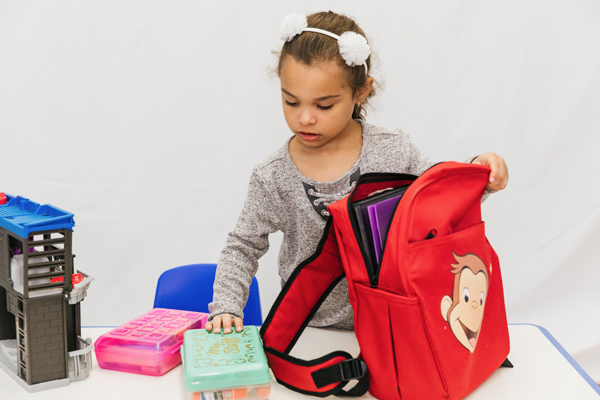School Transition
The Place recognizes the challenges of transitioning out of our program and into a new educational placement. To help our clients and their families navigate these changes as smoothly as possible, we provide an extensive school transition plan which can sometimes begin up to a year before a child ages out of our program. Below is a general overview of such a plan.

9-12 MONTHS BEFORE: Identify and target specific skills and behaviors that will be needed in the child’s next school setting and develop a personalized treatment plan accordingly.
- Target skills for daily living and classroom routines to enhance success in an educational setting (e.g., working in a group, walking in line, lining up at door, group story time, etc.) and to enhance independence.
- Identify foundational skills needed using a school readiness evaluation.
- Build in opportunities throughout the day to approximate the physical structure of the learning environment (classroom) and adult-to-student ratio in school.
- Reduce the child’s dependence on a single instructor and incorporate more opportunities to work with other adults.
- Conduct parent trainings regarding managing homework completion, developing afterschool routines, meeting other school expectations, etc.
Interested in ABA therapy for your child?
6 MONTHS BEFORE: Meet with parents to discuss Individualized Education Program (IEP) evaluations and determination of appropriate school for child to transition to.
- Meet with parents to discuss future placement, including determining the appropriate school the child will attend in the fall
- Help families identify next steps (i.e., have they contacted the school for an IEP re-evaluation?)
- Have our BCBAs attend IEP evaluations with the family if they prefer additional support
1-2 MONTHS BEFORE: BCBAs present Complete Transition Report to parents, conduct IEP team meeting, document progress and improvement areas.
- Family should schedule meeting with IEP team for 1-2 months out from school start date.
- BCBA Complete Transition Report: complete necessary assessments, document progress on goals and provide report to parent and school, summarize information concerning how the child learns, their communication system, behavior program, and instructional strategies that work.
- Meet with IEP team to discuss child’s room placement/ IEP meeting.
- Continue working heavily on school-readiness skills and developing materials to send with the child to school.
Additional Support:
- Tour: We ask to tour school with client once placement has been determined.
- Visual Supports and Social Story: We take pictures of the child’s classroom, common areas (gym, playground, lunch, etc.), and teachers. Create a “social story” to help prepare the child for the transition to come.
- “Meet and Greet”: We schedule “meet and greet” opportunities before school starts for students and teachers.
- Observation: We invite any school staff working with the child come to observe the child in the center so they have more of an opportunity to get to know the child and what works best for them.
- Staff Training: We offer to train any school staff working with the child on specific strategies that will be useful to a successful transition and daily routine or utilization of current visual supports.
We Change Lives Every Day
Enrollment is now open. Interested in our services? Reach out today to learn more about placement for your child.
Get Started
By clicking 'Submit', you agree to The Place for Children with Autism's Terms of Use and Privacy Policy. You consent to receive phone calls and SMS messages from The Place for Children with Autism to provide updates and information regarding your business with The Place for Children with Autism. Message frequency may vary. Message & data rates may apply. Reply STOP to opt-out of further messaging. Reply HELP for more information. See our Privacy Policy https://theplaceforchildrenwithautism.com/about-us/privacy-policy